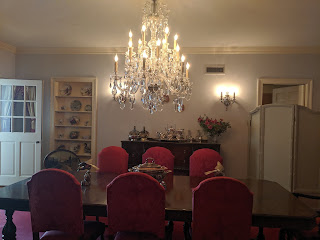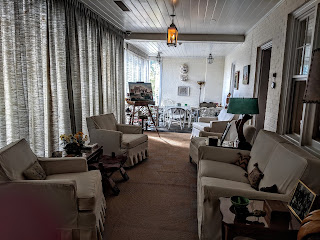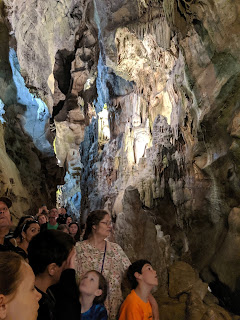 |
| A front view of the home of Dwight and Mamie Eisenhower. |
Eisenhower was born in 1890 in Denison, Texas, but became familiar with the Gettysburg area after his West Point graduating class visited the battlefield in 1915. This would be a busy time in Ike's life. He celebrated his nuptials the following year, marrying Mamie Geneva Doud and two years after that he was assigned to nearby Camp Colt, which was the first post to train soldiers to use tanks during World War I.
Ike's long army career kept him from putting down roots anywhere for years, so when he accepted a position as President of Columbia University in 1948, Mamie requested a permanent abode. Friends George and Mary Allen who lived on a farm in the area had nothing but nice things to say about the region, so the couple began their search.
By 1950, they had set their sights on what some have described as a "run-down" farm, for which they paid $44K. The fixer-upper wasn't without its charms. It was far enough off the road to retain a fair amount of privacy and fit the bill for Mamie's stipulation that the home pre-date the Civil War.
It would be years before the couple could move in, not exclusively due to the extensive renovations they undertook which would cost about $200,000, but also because Ike was named Supreme Commander Allied Forces Europe the year that they purchased the farm. The NATO position was very important to Eisenhower, who considered it the most important military job in the world, so he took leave from Columbia to fulfill his duties, part of which were to tour European capitals to convince them to bolster their defenses. In 1952, having completed what he set out to do in NATO, he stepped down and began two successful presidential runs, winning the presidency handily each time. The Eisenhowers began living in the house full time after President Kennedy's Inauguration in 1961.
Getting There
To purchase tickets to the Eisenhower National Historic Site, first visit the Gettysburg National Military Park Museum and Visitor Center, then take the shuttle bus to the Eisenhower property. There, a guide will provide background information on the Eisenhower farm before allowing entrance to the time capsule of a home, where 98 percent of the furnishings were owned by the family. Of course, today those furnishings are property of the Eisenhower National Historic Site.
The Rooms
Living Room
 |
| Ninety-eight percent of the furnishings in the Eisenhower house are original. |
 |
| I found this tufted circular sofa quite attractive, albeit unconducive to curling up with a book. |
 |
| The marble fireplace dates back to the presidency of Abraham Lincoln and was removed from the White House by President Grant in 1873. |
The attractive marble fireplace was removed from the White House in 1873 by President Grant and was an anniversary gift from the Eisenhower White House staff. The painting of Prague above the mantel was present to General Eisenhower by its citizens at the end of World War II. According to the guide, Ike spent little time in this room, declaring it to be "too stuffy."
Entrance Hall
 |
| Mamie asked that all visitors sign a guestbook located in the entrance hall. |
Mamie's love of the color pink is evident throughout the house and I found this hanging light to be especially pretty. This is the area where Mamie asked all visitors to sign her guest book. In the curio cabinet are Mamie's knickknacks, including a presidential plate she purchased from the nearby Stuckey's souvenir stand, along with plastic figurines of presidents and first ladies that she collected from cereal boxes.
Dining Room
Master Bedroom
Dining Room
 |
| A formal dining room for hosting family and friends. |
If you haven't figured it out by now, the Eisenhowers were rather down-to-earth folks. According to accounts, they preferred to dine on TV trays on the porch, but when family and friends visited, they ate dinner in the formal dining room. A tea service which guests will see on display was purchased by a young Ike for Mamie on a piece-by-piece basis with money he made on poker winnings.
Master Bedroom
 |
| Mamie's love of pink is evident in the Master Bedroom. |
During the years in which Mamie was first lady, it's said that the popularity of the color pink soared. This might be one reason why we see so many pink bathrooms in examples of mid-century modern homes and here in Mamie's own house.
 |
| Mamie's dressing room and bath. |
You'll see her favorite color repeated here in the master bedroom. Mamie was fond of taking a stick of wood with her favorite colors--green, pink and a cream color--on all of her military moves so that she could recreate what felt like home by rolling out her rugs and having the rooms painted in her favorite colors.
Maid's Room
 |
| The maid's room in the original portion of the house. |
Guest Rooms
A few of the guest rooms at the Eisenhower abode. The most famous visitor to spend the weekend was Prime Minister Nehru of India in 1956.
 |
| The "Yellow Room." |
 |
| "The General's Room," used by Ike as a dressing room and where he'd take the occasional nap. |
Kitchen
 |
| Compared to many of today's modern kitchens, this kitchen is rather modest. |
 |
| The Eisenhowers' favorite room was the porch where Mamie watched tv and played cards and Ike pursued his painting hobby. |
The porch was the Eisenhowers' favorite room and it's no wonder since the wall of floor-to-ceiling windows allow in so much natural light and the view isn't bad either. The full effect isn't apparent since the curtains are always pulled for preservation purposes.
Ike, who took up painting later in life, enjoying practicing his oil painting hobby here.
The Den
Ike spent many hours in his cozy den reading and playing bridge with friends. The fireplace you see here was built in. The architect designed the room to be built around the existing hearth from the former summer kitchen.
The Grounds
The Den
Ike spent many hours in his cozy den reading and playing bridge with friends. The fireplace you see here was built in. The architect designed the room to be built around the existing hearth from the former summer kitchen.
 |
| Ike spent hours reading here and playing bridge with friends. |
Upon exiting the house, guests can take a self-guided tour of the grounds and learn more about each stop by calling in to a special number which offers additional information on everything from the secret service office, to the guest house where David Eisenhower stayed one summer while working for his grandfather as a farmhand.
Because Ike loved his golf, there is also a putting green on the property, which was installed by the Professional Golfers Association.
To get a better idea of what the outside of the property looks like, I'll leave you with this short film, courtesy of Destination Gettysburg.
As we wind down the season, it's best to call to find out when tours will be held during the cooler months. You can learn more about this interesting and enduring piece of history in Pennsylvania by visiting the Eisenhower National Historic Site here.





































